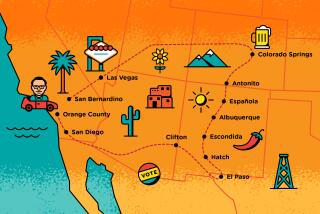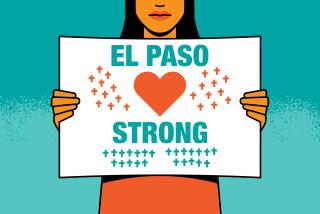South of the Border, Behind the Wheel: Survival Tactics : Driving: The author’s 10 years of negotiating Mexican highways have yielded ‘dos’ and ‘don’ts.’
- Share via
Going for a drive in Mexico? Prepare for wide-open vistas, red-earth canyons, spectacular displays of cactus to the north and thick jungle to the south. And in that spirit of broad expectations, be sure to bring your reflexes, your shock absorbers, your equanimity and a healthy appreciation for ambiguity.
In my own numerous road trips through Baja California and on the Mexican mainland during the last 10 years, the ambiguity is what has always confounded me most. You find yourself southbound on a winding highway, and the driver ahead of you, in a car with Mexican plates, sets his left-turn signal blinking. That blinking light could mean A) that the driver is going to change lanes or turn left, or B) that the driver sees a nice stretch of open road ahead and wants you to know that now would be a good time to pass him on the left. If the driver is another American tourist in a rental car, the answer is probably A. But if the driver ahead is a Mexican, the answer is probably B. All clear?
Earlier this month, in navigating a 730-mile loop from Guadalajara to Zacatecas to Guanajuato and back, a Times photographer and I were treated to that and many other lessons, some new, some old. Here’s our road log.
Kilometer 0: Yes, the distances are measured in kilometers, not miles. Also, gasoline is counted out in liters, not gallons. And if you’re renting a car, your costs are likely to be counted out in fairly large numbers. A week’s rental of a manual-transmission Nissan Tsuru or Volkswagen Golf from Hertz runs about $352, taxes and mileage included. If you want a larger car with automatic transmission, rates are almost double. For a week in an air-conditioned Chrysler Shadow, we paid Dollar Rent-a-Car $691, with mileage, extra insurance and taxes included.
Despite those prices, however, Americans shouldn’t count on a brand-new vehicle or a full tank of gas. The vehicle we picked up in Guadalajara had 55,000 kilometers (about 33,000 miles) on it and only fumes in the tank. Rental-car agency workers directed us to a nearby gas station, where we found that the air conditioning didn’t work and that even with the tank topped off the gas needle never pushed past three-quarters full.
Kilometer 175: Approaching a small town at highway speed, we glimpse a sign that says “Vibradores.” Before our minds can process the word, the car jolts violently as we bounce over a steeply pitched speed bump. Many roadside towns use these to keep long-distance drivers from speeding. The bumps are usually--but not always--announced by signs saying either vibradores (“vibrators”) or topes (“bumps”).
Kilometer 395: Cows in the road. Livestock on blacktop is a common sight on rural Mexican routes, and that’s one of many reasons not to drive after dark. Most highways are two-lane with scattered potholes and little or no shoulder. During the dark hours, Mexican highways are often dominated by truckers and bus drivers who know the road intimately, and cruise at amazing speeds.
Kilometer 646: “Maxipista,” says the sign. Appropriate response: rejoicing. Maxipistas and autopistas are the royalty of Mexican roads. They are usually also cuota routes--toll roads. Usually, they are divided highways with a lane for passing, and they are much better maintained than the libre (“free”) routes used by slow-moving local traffic. Though in Baja California, tolls usually run about $3 per station, we found mainland stations near Leon with tolls of $12. In one 200-mile day, we must have paid $30 in tolls. Still, for time and trouble saved, it was worthwhile.
Kilometer 821: First, rolling out of a hotel parking lot in Guanajuato comes a sickening, crunching sound beneath one of our tires. Three blocks later, on one of the city’s busiest streets, the thumping of our rear right tire makes it clear we have a flat. That’s the bad luck. The good luck is that half a block farther we rumble into the driveway of a llantera --a tire repair shop.
The mechanic raises the car on a jack, pulls off the afflicted tire, frowns at the spare I have pulled from the trunk. Clearly he has an economic interest here, but the spare doesn’t look too robust, and we have 200-plus miles ahead. We buy a new tire for $60. The spare goes back into the trunk.
Always carry enough cash to pay for a new tire; most roadside car-repair professionals in Mexico only work for cash. Always have a spare, because there may not be a mechanic down the street when your tire gives out.
Kilometer 1181: After seven days, we return the car. No discount for replacing their tire, no discount for the non-functional air-conditioning system. This doesn’t reflect well on Dollar, but from previous trips to Mexico I can say that these practices are hardly unique.
Further notes: U.S. driver’s licenses are valid in Mexico, but U.S. auto insurance is not, which is why those driving their own cars south are urged to buy insurance from an agency near the border or (for members) through the Automobile Club of Southern California. Also, those taking their own cars more than 12 miles across the border into the Mexican mainland face much more substantial paperwork requirements than those driving in Baja California. The Mexican Government Tourism Office in Century City, 10100 Santa Monica Blvd., Suite 224, Los Angeles 90067, tel. (310) 203-8191, and AAA offices can provide detailed information. Reynolds travels anonymously at the newspaper’s expense, accepting no special discounts or subsidized trips. To reach him, write Travel Insider, Los Angeles Times, Times Mirror Square, Los Angeles 90053.
More to Read
Sign up for Essential California
The most important California stories and recommendations in your inbox every morning.
You may occasionally receive promotional content from the Los Angeles Times.














